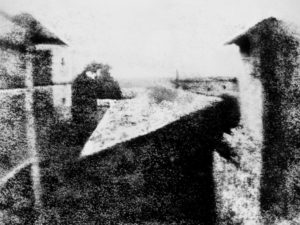

Thousands of years ahead of technology, the Greek philosopher Aristotle was already contemplating what would much later be called the “pinhole camera”. The earliest surviving photo of nature was taken in 1827 by the French inventor Nicéphore Niépce.
At that time, it took days of exposure for a photo to be ready. Today, 189 years later, we can see just how far photography has come. (Well, except for selfies. Those should probably not be considered progress, as far as humanity goes, anyway.) Photo Month was created to help us celebrate the invention of this incredible means of communication with previous and future generations, so let’s not let this day go to waste and make some memories!
- The inventor of photography was better known for his invention of propeller and boats. Cameras existed way before photographs were invented – they evolved from camera obscura and have been changing throughout centuries. The fist somewhat successful photograph was taken in approximately 1816 by Joseph Nicéphore Niépce. This took him eight hours of exposure to light, and the picture still was fuzzy. Maybe that’s why during his lifetime, Niépce was better known for his invention of a propeller for boats.
- The First Color Photograph Was Taken in 1861. The world’s first color image was the result of layering layering three separate images of red, green and blue filters. These were then projected onto a photosensitive plate with the corresponding filters.
- It was Thomas Sutton who suggested this process. This photographer and inventor created the first SLR camera around the same time as the color image.
He was also the one who developed the earliest panoramic camera with a wide angle lens in 1859. - The First Projected Image Was Through a Camera Obscura. This was a dark box with a tiny hole that let in light, and an upside view of the scene in front of the hole.
It is a literal translation from Latin, meaning Dark Room. The principle was first recorded by Mozi, a Chinese philosopher, between 470 to 391 BCE. This is the idea behind the pinhole camera. - The Daguerreotype Was the First Camera Capable of Recording an Image. Daguerreotype was a photographic process created by Louis-Jacques-Mande Daguerre. The entire process from start to finish was very complicated, but without it, we wouldn’t be where we are today. As it was the first image capturing device, it makes sense it was also the oldest. A camera made by French manufacturers Susse Freres (Susse Brothers) in 1839 sold in 2007 for almost $800,000.
- Kodak Doesn’t Mean Anything. Kodak has no real meaning. This might be hard to believe since many brands have a great connection between their product and their name. For example, Canon means a rule, law or principle. Ilford takes its name from its birthplace and Olympus is the home of the Greek Gods. George Eastman, the founder of Kodak said that the letter ‘K’ sounded strong, so he formed a word around it.
- The Cameras That Captured the Moon’s Surface Are Still There. When the Apollo 11 mission took off for the moon, they carried 12 Hasselblad cameras with them. They are still there, on the moon.
- The First Photography Paper Was Made Out of Asphalt.Well, it wasn’t made from the same stuff we make roads and pavements from. It was, however, made into varnish and applied to copper or glass plates. The asphalt, commonly known as Bitumen, was a black viscous liquid that was light-sensitive.
- The Most Viewed Photograph in History. It might go without saying, but the most viewed photograph is the default wallpaper for Windows XP. The image named ‘Bliss”, captured by Charles O’Rear in 1996. He didn’t make as much money as you would imagine. Microsoft bought the image from stock website Corbis.
- How Many Images Do We Capture Every Two Minutes? Every two minutes we snap more pictures than the whole of humanity did in the 1800s. Only a few million images were taken in the 80 years leading up to the first commercial camera. In 1999, Kodak reported that we had taken approximately 80 billion images. The estimate is that we share 730 billion images a year on Facebook, 255 billion on WhatsApp and 22 billion on Instagram. This is without counting Snapchat, iMessage and other apps.
- Cheerleader effect: Individuals seem more attractive on group photos than on individual portraits. Thinking about uploading a new photo on Facebook? Better pick one where you are around friends! According to the research of Drew Walker and Edward Vul at the University of California, individual faces appear more attractive when presented in a group than when presented alone. This phenomenon was called the “Cheerleader effect”.
- People never smiled on the old photos because they had to stay still for hours. Over the years, many theories have popped up trying to explain why people never smiled in old photographs. The most popular ones were that people didn’t want to show their bad teeth or that people thought smiling made them look ridiculous. In fact, due to insanely long exposure times, making one shot took hours.
- Research by Kelsey Blackburn and James Schirillo of Wake Forest University, North Carolina found that our left side is our ‘better’ side to be photographed.
- The word “photography” originates from Greek, meaning drawing with light.
- English photographer Eadweard Muybridge produced the first photo on movement in 1878 which subsequently set the stage for the first motion pictures.
- The first known photograph of a tornado was taken on 28 August 1884, about 22 miles (45 kilometers) southwest of Howard, South Dakota by an unknown photographer.
- The first underwater color photograph was taken off the Florida Keys in the Gulf of Mexico by Dr. William Longley and National Geographic staff photographer Charles Martin in 1926.
- A photo of the Machu Picchu was the first archaeology photo ever taken.
- The human eye equivalent of f-stop is f/8.3 in bright conditions and f/2 in dark conditions.
- If you think that cats are ruling the internet and YouTube in the 21st century, then you are completely wrong. Their photos are ruling the hearts of humans since the 1870’s. It all started when Harry Pointer started taking normal pictures of cats. But, he soon realized that humans love the crazy side of the cats.
- We generally use ‘photo’ for the word photograph. But, did you know who used the word photo first? It was Queen Victoria. She wrote the word for the first time in a letter she wrote in 1860. What about a megapixel? It was used for the first time in 1984.
Sources:












